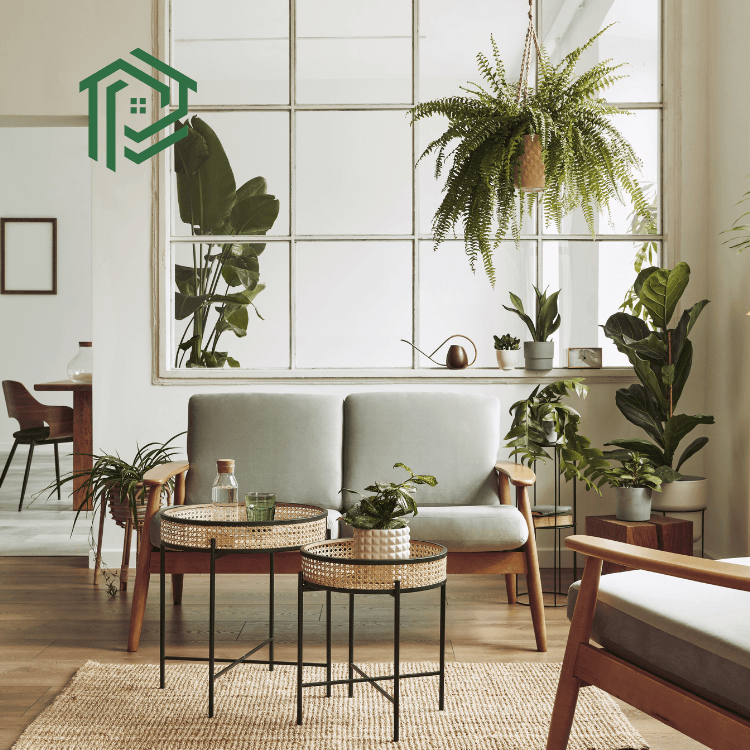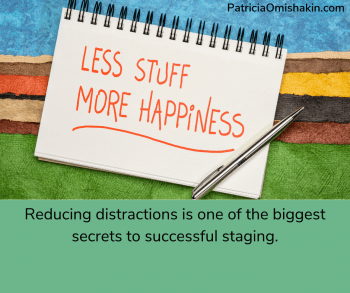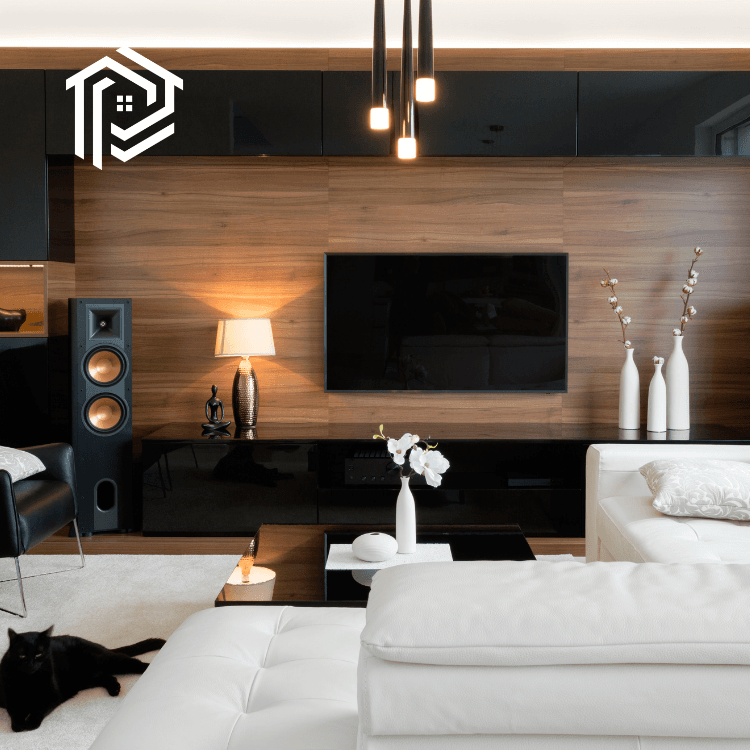
How To Self-Stage Your Home In Tennessee
Last Updated on May 22, 2025 by Patricia Omishakin
STAGING MEANS MORE THAN SIMPLY ADDING NEW FASHIONS
AND FURNISHINGS TO YOUR HOME. STAGING MEANS
UNDERSTANDING THE PSYCHOLOGY OF LIVING IN A HOME,
AND USING THOSE UNDERLYING SECRETS TO YOUR OWN
ADVANTAGE, RATHER THAN TO SELL.
Staging means setting up your home with nice furnishings and decor so that home buyers can imagine themselves living in a clean, clutter-free, stylish home.
No one actually lives like a staged home looks. In fact, when home sellers have their homes staged, they always spin around and say, “I wish I had done this before selling, so I could have lived here like this.”
But wait! Rather than staging to sell, how about staging for life—so you can live in it? By taking a fresh look at your home and making a few bold changes, you can impart much of the feeling that comes from a completely staged home, even if you have no interior design experience. This two-part report will show you how. First you’ll learn the secret of minimizing distractions—which is the real reason that staging works. And then you’ll learn a few ‘style basics’ to help enhance your environment.
• Part 1: Distractions and Tolerations
• Part 2: Interior Design Basics
PART 1: DISTRACTIONS AND TOLERATIONS
WALLOWING IN DISTRACTION
In every era of mankind, it can be said that somebody turned to somebody else and said, “Things are a lot more hectic today than they used to be.”
And in every case, they were right. Every era of mankind has grown more complex and hectic. That doesn’t mean life is harder from one era to the next. But it is hard in a different way. In our world today, for example, we’ve taken the expectation of personal productivity to new heights. It’s barely acceptable any more to not be available by phone, and people will complain about not being able to get hold of a person in minutes. Vast numbers of people oversee us, from our friends and family who demand our attention by phone and Facebook, to our kids and partners to want to be entertained, to a plethora of unskilled bosses in an increasingly stratified corporate world. It’s a recipe for stress.
Perhaps one of the most important survival skills in this current world view is our ability to manage distractions. Distractions are things that take our attention away from what we’re trying to focus on. Think “texting and driving,” or “walking and chewing gum.” These are things that aren’t supposed to go together, but we do them together, just as we eat and drive, program the GPS and drive, do our makeup, read, and talk while we drive. And while doing one of those things, our coordination for doing the other slips.
Beyond technology, we’re also distracted by our own thoughts. With competing demands on our attention and time, we’re always thinking about several tasks at once—multitasking mentally as well as physically. And our world has become intensely mental. While our grandmother might have multitasked by getting all the parts of a good meal on the table at the same time, we must be evaluating different ideas, planning multiple programs, writing several different reports, and thinking about how to keep everyone happy.
Thich Nhat Hanh is a Vietnamese Buddhist monk who tells us in his book called Happiness, that we should do things mindfully. His meaning is to be aware in the moment you are in of all that you are doing. When you are walking, think about walking. When you are sitting, think about sitting. When you are driving, think about driving. He says, “The present moment is the only moment that is real. Your most important task is to be here and now and enjoy the present.”
What’s the point in that, right? If you can multitask and you need to get a lot done, what is the point in slowing down and focusing on one task at a time? Well, for one, if we’re talking about driving, it’s safer. But more to the point, Thich Nhat Hanh is not talking about being able to do something better because you’re focused. He’s talking about calming the mind, something that has measurable benefits in relieving stress.
(Stay with me…this all goes back to staging in just a moment.)
A calm, still mind is more able to detach from complexities and feel at peace. A peaceful mind is better able to connect to abundance and win-win thinking. It is said by the Buddhists that a person will have become enlightened when he does not have a single thought for one whole minute.
The person who can effectively manage distractions is likely to be more attractive to others. For instance, networking events are wonderful places to view distracted minds. You walk into the room and the first thing you do is walk up to someone and catch their eye to see if you can get into conversation with them. You can tell instantly if they’re “with you” or not. Sometimes it’s subtle, a frozen smile, a flick of the eyes. Other times it’s more overt with them turning and talking to other people in the middle of your conversation. And then other times you feel like you’re the only person in that other person’s world right then. Ah, that feels nice.
The practical application of this discussion is that the act of reducing distractions in our home space instantly puts our minds into a more receptive state, calming our stress, and improving our health and relationships. Wow, that’s a lot of goodies from just reducing distractions and simplifying where our attention goes.
By decluttering our space, arranging furniture to appeal to the eye, reducing messes, harmonizing colors, and simplifying your décor, we gain a huge amount of peace in our home space. Have a look at these two pictures. Which room would you rather walk into at the end of a hard day at work?
Reducing distractions is one of the biggest secrets to successful staging. Removing clutter and putting thing in order, as well as using a few well-placed large pieces of art or furniture in place of a bunch of scattered pieces make a room feel more peaceful—and that sense of peace is one of the reasons that staged homes sell faster than un-staged homes.
WALLOWING IN DISTRACTION
Then there’s the evil cousin of distractions—tolerations. Tolerations are a kind of distraction that we don’t acknowledge. Tolerations are usually tiny distractions we ignore, but that are in our peripheral vision and at the edge of our consciousness. I remember a neighbor coming to visit for the first time. I wanted to make her feel welcome, so I started to show her around the house. It was only then that I noticed the cobwebs hanging from the ceiling, the hole in the door screen, and the streak of dirt by the front door where the dog jumped up. And when she asked to use the restroom, I suddenly remembered the moldy tile in the bath surround. I was distracted during her brief visit, and probably looked and acted apologetic.
I mentioned all this to a friend later, and we talked about how the cumulative effect of tolerations can become a drag on our spirit, awareness, and energy. I wanted to enjoy my neighbor, and all I could think about was little crap that I should have taken care of. I’m sure the neighbor felt some of my embarrassment, even if she didn’t know why.
The experience made me look around my house and realize how many of these little details I had been tolerating without really noticing.
Tolerations can consist of a multitude of small, petty details—like a dirty car, the torn curtain, a spot on the floor, the annoying piece of tape stuck to our computer, the door in the bathroom that sticks. Or they can be large projects—like the house needs painting, the filing system is in disarray, the car is too small for a growing family.
One reason staged homes appeal to us is that they have eliminated the tolerations. Buyers feel good without even knowing why, because there’s nothing to take care of…no tolerations have built up to dampen their energy. They don’t see any cobwebs or curled linoleum, because those things have been taken care of in a well-staged home.
EXERCISE: ELIMINATING TOLERATIONS
Step 1: Petty tolerations
- Look around in your immediate environment from where you’re sitting right now. Make a list of everything you see that is out of place, broken or torn, too small or large, crooked, cluttered, a dissatisfying color, etc. Do this for every room in your house. Do the same in your office workspace and car.
- Place these lists where you can see them prominently. They are your visual existence system to help you remember what needs to be done.
- Make a commitment to fixing just one item from this list each day. Cross off each item as it is done. Fix it mindfully.
Step 2: Major tolerations
- Look around your house, yard, car, and work environment. Make a list of projects that need to be done, including painting, cleaning, organizing, repairing, replacing, etc.
- Prioritize the list. Then put the first project onto a schedule. Identify the intermediate steps that need to be done to make that project a reality, such as getting bids, tracking down service providers, saving money, etc.
PART 2: INTERIOR DESIGN BASICS
In addition to looking at tolerations in your physical space, consider the following more traditional suggestions for staging your home, while eliminating tolerations:
Consider emptying an entire room before you start any DIY staging efforts. By creating a blank slate, you’ll be more creative. Then consider these three things elements: paint and flooring colors, window coverings, and finally art pieces. Identify a color scheme for all of these elements. If you already have flooring and don’t plan to replace it, that may be the start of your color scheme.
Choose new paint colors to complement the flooring. If you can’t afford new furnishings to match the color scheme, consider new pillows or a slip cover. Consider installing crown molding and new baseboards at this time, or building a new fireplace surround or mantle. Finally, choose window coverings that tie the paint, flooring, and furniture together. When moving furniture back into the space, look for ways to leave some things out of the room altogether. The most valuable feature of staged homes is the absence of clutter.
When replacing furniture in the room, position it in different ways. Try configurations you think can’t possibly work, such as setting the couch at an angle and adding a sofa table behind it. Also consider adding plants to your space. As you replace furnishings, also remember the ideas of absence of distractions and elimination of tolerations.

FIND A WAY TO MATCH PIECES
If you have mis-matched shelving or other furniture for the room, consider replacing some of it, or refinishing it all to have a similar finish. For instance, if you have one rattan chair, a wooden IKEA shelf unit, and a 1960’s coffee table, you may be creating dissonance in your space. Consider ridding yourself of one of these elements, then replacing it with something that matches one of the other elements.
Perhaps removing the 1960’s table and replacing it with an IKEA table will draw the room together. Perhaps replacing the rattan chair with a 1960’s era arm chair might draw the room together in a retro way. The more your furniture looks as though it is from the same style or era, the more together your room will look.
Another idea for matching pieces is to choose one finish and alter other pieces to have similar finishes. For instance, if you have a blonde wood coffee table, a golden oak shelving unit, and a black lacquered TV cabinet, you have mismatched finishes. If you want to keep the black TV cabinet, consider sanding and using black lacquer paint to refinish the coffee table and shelf unit. If you don’t want to keep the black TV cabinet, but like your blonde wood coffee table, consider replacing the TV cabinet and sanding and lightening the stain of your shelf unit. For some wood furniture, you might consider distressing it and using a white-wash finish.
REMOVE CLUTTER WITH STORAGE
It’s been said many times. A well-staged home is a clutter-free space. If you struggle to manage clutter, the best thing you can do for yourself is to first throw everything away that you almost never use. If it has sentimental value, or you use it rarely but need it when you do, then you will find a home for it in the garage, attic, or storage area. You can also take photos of some older cherished items that you don’t really need to hang onto any longer.
Speaking of storage areas, if clutter controls you, one of the first things you need to do is purchase cabinets with closing doors. Many people get clutter around the phone area in or near the kitchen. If that’s you, purchase a cabinet that can rest in this area and hold a lot of that clutter. One friend of mine bought an extra upper kitchen cabinet to match the rest of her kitchen, then placed it on the floor under the bar countertop next to the bar stools. That is the place where the kids shove all of their art supplies that they use while sitting at the counter.
Clutter goes beyond counter tops. Clutter can include too many pieces of furniture and too much art on the walls, but that may be a matter of taste. I know people who love knick-knacks and every square inch of their homes is covered with these treasures. They are clean, well-organized homes for the most part, thought one is just junky, with stuff crammed into shelves so tightly that it can’t even be seen.
If clutter is a problem for you, focus intensively on creating cabinets and spaces for your stuff. As my mother always said—a place for everything and everything in its place.
FINAL WORD
Staging is not just about renting expensive furniture and creating a designer interior to sell your home. Staging is also about staging for life—creating a space you enjoy living in, one that contributes to your sense of well-being. By eliminating distractions and removing tolerations, you open up your mind to focus on other, more important things in life. And by matching colors, matching furniture styles, and creating significant extra storage for all your “mustkeep” small items, you create a relaxing environment that soothes you, much like a great piece of art or a perfect place in nature. Your home will make you feel good, not just be a place to get out of the rain.





